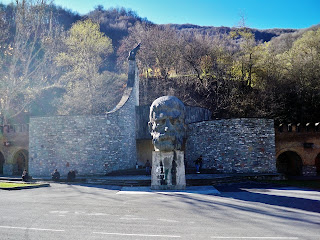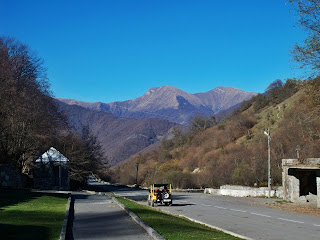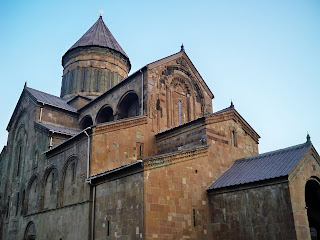გამარჯობა მეგობარები!
Hello friends!
Hope all is well wherever you currently find yourself (Since
apparently people are reading my blog all
over the world?!! The Blogger
website tracks what countries people are reading my blog in and the stats are
really interesting to keep track of!).
Once again I had another lovely and exciting adventure this past weekend
in this crazy country of Georgia that I want to share with you all!
On Saturday, a
few of my friends from TLG orientation and I got up bright and early (6am!) to
meet up with the same woman who organized my trip to David
Gareja. This time though our trip
was to two places about four hours away from Tbilisi: Rabati castle in Akhaltsikhe
and Vardzia Caves.
Our first stop
was the Rabati Castle in the town of Akhaltsikhe which is about
13 kilometers (8 miles) from the Turkish border. The Rabati castle was built in the 13th
century and overlooks the town. Throughout
its history, Akhaltsikhe has been under the control of many different groups of
people notably the Ottomans during the 17th and 18th
centuries, and the Russian empire for most of the 19th-20th
centuries. Now, under control of the
Georgians once more, it underwent a huge renovation and recently reopened in
August 2012. Now the Georgian government
hopes it will serve as a tourist attraction for Georgians and foreigners alike.
The entire site
contains a museum, a castle, a church, a mosque with minaret and a synagogue
which was really cool to see architecturally side-by-side. We had a quick tour of the place by a
Georgian guide (most of which was understood through a rough translation by all
of us). The final part of the tour
included a walk through an impressive museum that contains many artifacts
uncovered in the area including pottery, weapons, money, religious artifacts and
jewelry dating back thousands of years and discovered right here in
Georgia! Georgia’s history goes farther
back than I could have imagined prior to coming here! After this whirlwind tour we were free to
explore Rabati and take pictures:
.jpg) |
| The view of Akhaltsikhe from the castle area |
.jpg) |
| There were really interesting fountains throughout some of the newer renovated areas |
.jpg) |
| view from outside the complex |
.jpg) |
| A pretty garden, also showcases some of the different architecture throughout the place. |
.jpg) |
| The view from up in the castle |
Our second stop
was Vardzia caves about an
hour’s drive winding through the mountains from Rabati. It’s Georgia’s most famous cave city. Back in the day, the Georgian country was
ruled by a Strong Independent Woman by the name of Queen
Tamar (r. 1184-1213) who was the first (and only woman thus far) to ever
rule Georgia. Considering the state of
gender inequality in Georgia now, it’s interesting that she was so powerful and
remains a revered ruler in the country’s history. She faced some opposition coming to power as
a woman, yet then showed everyone how great she was by then guiding Georgia
into one of its most prosperous time periods.
It was during
Tamar’s reign that much the Vardzia caves and the monastery were constructed
(the 12th century). It was created
in the side of the mountain to protect monks there from invading neighboring empires
such as the Mongols, the Turks and the Persians. In the sixteenth century the place was
finally conquered and the monks were driven away from this safe haven. It’s been partially destroyed by a few
earthquakes so that now only 600 caves remain from an earlier 3,000. In modern times, Georgian monks have returned
here to live and pray, so some of the caves are off-limits to tourists.
.jpg) |
| View of the caves from the road |
.jpg) |
| The other beautiful view |
.jpg) |
| It really was cold and windy |
.jpg) |
| some of the caves |
.jpg) |
| Paintings that remain by the entrance to the church |
.jpg) |
| Apparently the name Vardzia comes from the story that when lost in the caves Queen Tamar shouted to her uncle, "აქ ვარ ძია" (ak var dzia) which translates to, "I am here, uncle." |
.jpg) |
| more caves |
The weather was
a little breezy and cold, but the trip to Vardzia was actually really calming
and beautiful. Some of the only sounds
to be heard were the rushing of the nearby river amidst the occasional shout-out
to a friend in another cave; there are only a few houses on the outskirts of
the area and the views of the surrounding hills and mountains are stunning with
the late fall colors. I find excursions
like these are especially awesome in that we get to physically touch and climb
all over things that are literally hundreds of years old and are so special to
the Georgian people. You can’t always do
that in other places around the world!
Well I’m staying
in the village this weekend, but more adventures to come! Under 40 days left!
Until next time, nakvamdis (“goodbye” in Georgian)!!
Kelsey

















.jpg)
.jpg)




.jpg)
.jpg)
.jpg)
.jpg)
.jpg)
.jpg)
.jpg)
.jpg)



.jpg)


.jpg)
.jpg)
.jpg)
.jpg)

.jpg)
.jpg)
.jpg)
.jpg)
.jpg)
.jpg)
.jpg)
.jpg)
.jpg)
.jpg)
.jpg)
.jpg)
.jpg)
.jpg)
.jpg)
.jpg)
.jpg)